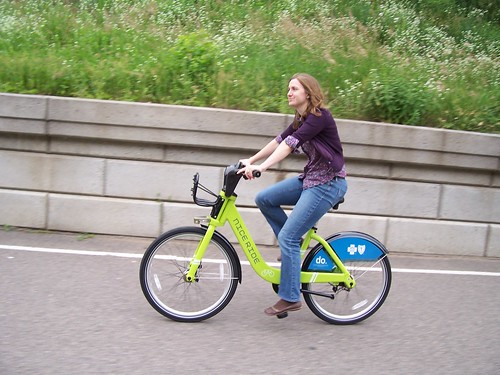For the past several years, there have been ongoing discussions within the cycling community about why women are statistically underrepresented in cycling rates, and what we should do about it. There continues to be disagreement. The only thing we know for sure, is that women are, in fact, statistically underrepresented. Beyond that, disagreement, speculation, or conflicting research.
What we know:
- Census Journey to Work data suggests that women account for 23% of cyclists nationwide.
- American Community Survey suggests that women account for 37% of cyclists in Minneapolis.
What we don’t know:
- Why?
- What to do about it?
And let me explicitly state that I don’t know the answer to either of these questions.
A lot of the discussion dates back to a 2009 article in Scientific American titled How to Get More Bicyclists on the Road, subtitled To boost urban bicycling, figure out what women want.
From the article:
Women are considered an “indicator species” for bike-friendly cities for several reasons. First, studies across disciplines as disparate as criminology and child rearing have shown that women are more averse to risk than men. In the cycling arena, that risk aversion translates into increased demand for safe bike infrastructure as a prerequisite for riding. Women also do most of the child care and household shopping, which means these bike routes need to be organized around practical urban destinations to make a difference.
Scientific American wasn’t the first source to suggest the idea that women are a sort of “indicator species”, but it may have been the first widely distributed source that reached a more diverse audience than anything published in academic circles. From this article and the mention of “risk aversion” seems to spring the idea that traditional bike lanes just aren’t an attractive enough facility type for women, and that we should consider building safer types of facilities (roughly defined as the more separated bike boulevards or cycletracks) if we want more women to cycle. The article is quick to point out that “good infrastructure alone won’t improve women’s cycling rates”, but that disclaimer hasn’t gotten nearly as much press as the general assertion that perhaps women demand safer types of bike facilities than men.
This assertion makes me a bit uncomfortable, and the “indicator species” idea has been repeated in ways that I find a bit distasteful. For example, this post from People for Bikes lumps women together with children and seniors and can be crudely characterized as “Dutch Cycling: So Safe, even Women Do It!”, which is both absurd and offensive, although I realize the author would surely object to that characterization.
Of course there are many alternate voices as well pushing back against the idea that women have inherently different cycling preferences than men. Perhaps most notably, Elly Blue posted an article at Grist called Bicycling’s gender gap: It’s the economy, stupid:
Why don’t more U.S. women ride bikes?
The two theories you hear bandied about the most are fear and fashion.
[…]
There’s plenty of truth in both the fear and fashion theories. But before we commit to blaming women’s transportation practices on our timidity and vanity, I think it’s worth looking at some other potential factors.
Like the economy.[…]
What we do need is the same that that men need — roads that are good places for bikes, and lots of other people out there bicycling and making them even safer.
We need a world in which bicycling isn’t about gender and in which nobody has to write articles like this one.
(Please click through to read the rest of her excellent post.) Also, see other local authors contributing to the discussion here, here, and here.
Part of my concern about the “indicator species” language, or generally the idea that women prefer safer types of facilities than men, is that it seems to perpetuate gender inequalities more than it effectively addresses them. If women want different facilities, is that an inherent gender preference, or is it more likely a symptom of inequalities elsewhere in society? And if it is more likely the result of inequalities elsewhere, how does that inform the way we make infrastructure decisions?
So what does this have to do with Minnesota (this is, after all, a local blog about local topics, right)? Well, I guess only that I’ve heard this “indicator species” language from a couple of local sources recently, including the idea that the recent local emphasis on developing bicycle boulevards may help lessen the cycling gender gap. And in each case, the discussion has made me bristle, and seemed a bit off-key. At least for the near-future, I intend to stick to more gender-neutral language when discussing the pros and cons of infrastructure options, but not everyone will agree with that decision. How about you?

